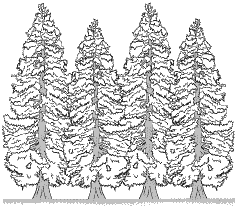Adaptation of Trees
How have temperate coniferous trees adapted to the natural environment?
 |
|
|
| • Needle leaves have a small surface
area and are waxy which reduces water lost by transpiration. Both of these
adaptations are important as these trees grow in low rainfall areas, often less
than 500mm per year.
• Dark forest floor and acid pine needles limit ground vegetation and competition for nutrients. • Cones protect seeds from extreme winter cold and summer forest fires. • Resinous bark protects trees from extreme winter cold. • Wide, spreading roots to:
|
||
